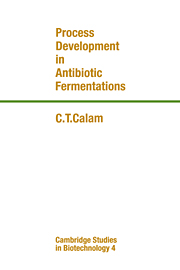Book contents
- Frontmatter
- Contents
- Preface
- Part 1 Background
- 1 Introduction
- 2 The microorganisms and methods of culture
- 3 Microbial Physiology
- 4 Microbial biochemistry
- 5 Subsidiary factors important in production fermentations
- 6 Submerged culture conditions: the interaction between environment and genotype
- Part 2 Process development in the laboratory
- Part 3 Industrial fermentation plants and pilot plants
- Postscript
- Bibliography
- References
- Index
2 - The microorganisms and methods of culture
Published online by Cambridge University Press: 05 February 2012
- Frontmatter
- Contents
- Preface
- Part 1 Background
- 1 Introduction
- 2 The microorganisms and methods of culture
- 3 Microbial Physiology
- 4 Microbial biochemistry
- 5 Subsidiary factors important in production fermentations
- 6 Submerged culture conditions: the interaction between environment and genotype
- Part 2 Process development in the laboratory
- Part 3 Industrial fermentation plants and pilot plants
- Postscript
- Bibliography
- References
- Index
Summary
Before we move to a detailed account of the behaviour of antibiotic fermentations and their development, the present chapter is intended to briefly describe the organisms used, methods of culture, mode of growth, and general behaviour, based on a consideration of ordinary microorganisms rather than special high-yielding mutants. This will be illustrated by two student-type experiments. However good the descriptions may be, they can never be as useful as a visit to a laboratory where work is in progress, which will bring out the methods used and the type of expertise required for success.
The isolation of antibiotic-producing microorganisms
General screening techniques
Antibiotic-producing organisms are obtained as a result of search programmes. Fungi and streptomycetes are isolated from soils and other materials by plating samples and picking off suitable colonies. This procedure is outlined later in this chapter. The isolated colonies are transferred to slopes and tested in a suitable manner. A modern isolation and test system has been described by Nolan (1986). Targets of 10 000–100 000 colonies, tested annually, are achieved by growing the isolates in small cups in a stationary block, using a liquid medium. The solutions obtained are then diluted and screened en masse, the tests being conducted in similar blocks. These are then read using a computerised system that not only records the test results but also compares these results with those from previous tests (held in memory) and with a target pattern and picks out any that show the desired pattern. This avoids a personal and painstaking study of the data, which can be time consuming and subject to error.
- Type
- Chapter
- Information
- Process Development in Antibiotic Fermentations , pp. 9 - 24Publisher: Cambridge University PressPrint publication year: 1987

